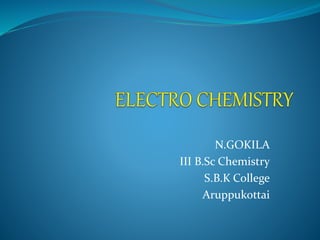
Electro chemistry
- 1. N.GOKILA III B.Sc Chemistry S.B.K College Aruppukottai
- 2. Content Terminology Types of cells Types of electrodes Single electrode potential Measure of Single electrode potential Standard electrode potential Electro chemical series and significance Nernst equation derivation Electrochemical passivity Determination of solubility products of sparingly soluble salts
- 3. Calculation of ΔG, ΔH, ΔS and K for cell reaction Chemical cells with and without transference Application of EMF measurement Determination of PH using hydrogen electrode, glass electrode and quinhydrone electrode Westom Cadmium cell
- 4. Terminology Electrode It is a device made by introducing metal into its own ionic solution where either oxidation or reduction taking place. Oxidation Removal of electron from a metal is called oxidation. m→mn++ne-
- 5. Reduction Gain of electron by a metal ion is called reduction. mn++ne- → m Oxidation electrode It is a device made by introducing metal into its own ionic solution where oxidation taking place. e.g
- 6. When Zn metal rod is placed in the Zn2+ionic solution (ZnSO4 solution)Zn metal goes into Zn2+ions into the solution by leaving its electron on the Zn metal rod . So that the electronic charge on the Zn-metal rod is increased. Zn→Zn2++2e- Reduction electrode It is a device made by introducing a metal rod into its own ionic solution where reduction tacking place.
- 7. e.g When Cu-metal rod is placed in the Cu2+ ionic solution (CuSO4 solution) Cu2+ions get deposited as copper on the Cu-rod . So that the electronic charge on the Cu-metal rod is decreased. Cu2++2e- → Cu
- 8. Electro chemical cell It is a device made by joining oxidation electrode and reduction electrode where electrical energy is produced by redox reaction.
- 9. At oxidation electrode (anode) Zn→Zn2++2e- At reduction electrode (cathode) Cell reaction Zn+ Cu2+ → Cu+ Zn2+ As a result of cell reaction electrons flow from Zn-rod to Cu-rod and SO42- ions migrate from reduction electrode to oxidation electrode through salt bridge . That makes the flow of negative charges in the above circuit is completed and the current flow is noted in the ammeter . In the absence of salt bridge , no current flow through the ammeter and no reaction takes place in the cell Cu2++2e- → Cu
- 10. Types of cells Reversible cell Irreversible cell Reversible cell It is a device in which a state of equilibrium is existed in the cell reaction. i.e, a) If the external emf is equal to the cell emf , no cell reaction takes place. b) If the external emf is infinitesimally smaller than the cell emf , the current will flow from the cell by the cell reaction. c) If the external emf is infinitesimally greater than the cell emf , the current flow into the cell and the cell reaction gets reversed.
- 12. Cell reaction Zn+ Cu2+ Cu+ Zn2+ If EMFexternal infinitesimally smaller than the EMFcell the forward reaction is occur. Zn+ Cu2+ → Cu+ Zn2+ If EMFexternal infinitesimally greater than the EMFcell the backward reaction is occur. Cu+ Zn2+ → Zn+ Cu2+
- 13. Irreversible cell It is a cell in which a state of equilibrium is not existed in the cell reaction.
- 14. If the EMFexternal infinitesimally smaller than the EMFcell the , the cell reaction is At anode : Zn→Zn2++2e- At cathode :2H++2e- →H2 Cell reaction Zn+ 2H+→Zn2++H2 If EMFexternal infinitesimally greater than the EMFcell the cell reaction is At anode : At cathode : 2H++2e- →H2 Cell reaction Cu+ 2H+→Cu2++H2 Cu → Cu2++2e-
- 15. Types of electrodes Metal – metal ion electrode Gas electrode Metal-metal salt electrode Oxidation – reduction electrode
- 16. Metal – metal ion electrode It is made by introducing metal into its own ionic solution in which the electrode reaction is reversible with metal ions. (e.g) Zn –Zn2+ ion electrode Electrodic reaction Zn oxidation Zn2++2e- reduction
- 17. Gas electrode It is made by passing into the corresponding ionic solution in the presence of platinum metal in which the electrodic reaction is reversible with respect to the ions of the gas. (e.g) hydrogen electrode it is made by passing through the hydrogen gas into the HCl acid in the presence of Pt metal in which the electrode reaction is reversible with respect to the H+ ions.
- 18. electrodic reaction H2 2H++2e- Metal-metal salt electrode It is made by taking the metal and its sparingly soluble salt in the saturated solution of salt having the same anion in the presence of Pt wire in which the electrodic reaction is reversible with respect to the anion. (e.g) calomel cell It is made by taking the Hg and calomel(Hg2Cl2) to the KCl solution in the presence of Pt wire oxidation reduction
- 19. If the electrode reaction is oxidation 2 Hg (l) 2 Hg++2 e- 2 Hg+ + 2 Cl- Hg2Cl2 2 Hg (l) 2 Cl- Hg2Cl2 +2 e- i.e there is a fall in concentration of chloride ions
- 20. Oxidation – reduction electrode It is made by taking platinum metal in the solution containing ions of the same substance in two different oxidation state like Fe2+ and Fe3+ ions or Ce 2+ and Ce3+
- 21. The electrode reaction is Fe2+ Fe3++e- Here the potential of the electrode arises from the tendency of the ions in one of the oxidation state to change into the other more stable oxidation state